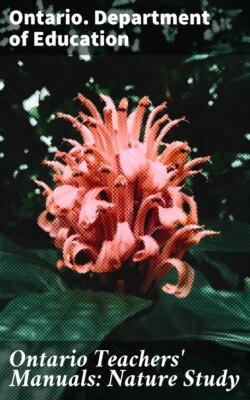Читать книгу Ontario Teachers' Manuals: Nature Study - Ontario. Department of Education - Страница 52
На сайте Литреса книга снята с продажи.
PLANT COLLECTIONS
ОглавлениеTable of Contents
The instructions given below for collecting, pressing, and mounting plants are applicable to wild flowers, grains, grasses, and weeds.
The specimen.—Select a plant which in form and size is typical of its species and which is in full flower. Care must be taken to dig down and secure the root.
If the plant is too large for the mounting sheet, cut out the central part, and use the root, lower leaves, upper leaves, and flower. If the root is very thick, cut slices lengthwise off the sides so as to reduce it to a flat form that is not too bulky.
Before the plant has had time to wither, spread it out flat on a sheet of paper and spread another sheet over it, taking care to straighten the leaves and flower out. Blotting-paper is preferable, but any soft paper that will absorb moisture will make a very good substitute.
Pressing and drying.—Place several sheets of paper above and below the specimen. Any number of specimens prepared as described in the last paragraph may be placed in a pile, one over another, resting on the floor or on a table. Place on top of the pile a board which is large enough to cover the surface of the pile, and on the board place a weight of about fifteen pounds of bricks, or other convenient material. A box containing sand, stones, or coal may be used in place of the board and weights. The weight prevents the shrivelling and distortion of the plants.
To prevent discoloration and mildewing of the plants, the papers around them must be changed at the end of the following successive intervals: two days, three days, five days, one week, etc., until they are quite dry. The length of time required for pressing and drying depends upon the quantity of sap in the plants and also upon the dryness or humidity of the atmosphere.
Mounting.—When dry, the specimens are mounted on sheets of heavy white paper. These sheets are cut to a standard size, eleven inches by fourteen inches, or sheets of half this size, namely, seven inches by eleven inches; are permissible. The best method of attaching the plant to the sheet is by pasting narrow strips of gummed paper across the plant in such positions as will serve to hold all parts of it in position.
Labelling.—The name of the specimen, the date of collection, the place from which collected, and the name of the collector are to be neatly written in a column in the lower right-hand corner of the sheet. Printed labels which are pasted on this corner of the sheet are also used.
Collections of leaves may be prepared by the same process as that given for plants. Leaves will retain their autumn tints if their surface is covered with varnish or paraffin, which will prevent the admission of air.
To cover with paraffin dip the leaf for a moment into melted paraffin.
